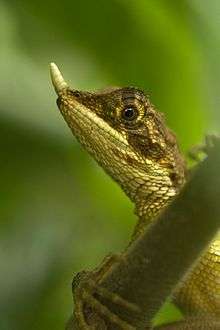Rhino-horned lizard
| Rhino-horned lizard | |
|---|---|
| Male | |
 | |
| Female | |
| Scientific classification | |
| Kingdom: | Animalia |
| Phylum: | Chordata |
| Class: | Reptilia |
| Order: | Squamata |
| Suborder: | Iguania |
| Family: | Agamidae |
| Genus: | Ceratophora |
| Species: | C. stoddartii |
| Binomial name | |
| Ceratophora stoddartii Gray, 1834 | |
The rhino-horned lizard (Ceratophora stoddartii ), also commonly known as Stoddart's unicorn lizard and the horned agama, is a species of lizard in the family Agamidae. The species is endemic to Sri Lanka. It is called kagamuva angkatussa-කගමුව අං කටුස්සා in Sinhala.
Etymology
The specific name, stoddartii, is in honor of Charles Stoddart, who was a British army officer and diplomat.[1]
Habitat and distribution
C. stoddartii is found widespread in montane forests of central Sri Lanka. Localities from which it has been recorded include Nuwara Eliya, Hakgala, Pattipola, Ohiya, Horton Plains, Hewaheta, Dimbula, Agarapathana, and Adam's Peak.
Description
The head of C. stoddartii is oval, and longer than wide. The rostral appendage is long, horn-like, about two thirds the length of the snout in males, but is reduced or even absent in females. The lamellae under the fourth toe number 23–27. The dorsum is brownish green or yellowish brown. The tail is marked with 10–16 dark brown crossbands. The venter is light brownish gray.
Ecology and reproduction
A slow moving, arboreal species, C. stoddartii is found on trees from 1 to 2 m (3.3 to 6.6 ft) above the ground. When threatened, it opens its mouth wide, revealing the bright orange lining of the oral cavity.
Reproduction
C. stoddartii is oviparous. Egg laying takes place in July, and clutch size is about 2–5 eggs, each measuring 7.6-8.1 by 13.5–14.5 mm (.31 by .55 inch). The eggs are deposited in a hole, and hatch after 81–90 days. However, hatchlings have been founded in the wild also during colder months such as December and January.
See also
References
External links
Further reading
- Boulenger GA (1890). The Fauna of British India, Including Ceylon and Burma. Reptilia and Batrachia. London: Secretary of State for India in Council. (Taylor and Francis, printers). xviii + 541 pp. (Ceratophora stoddartii, p. 119).
- Gray JE (1834). Illustrations of Indian Zoology; Chiefly Selected from the Collections of Major-General Hardwicke. Vol. II. London: Adolphus Richter. Plates 1-102. (Ceratophora stoddartii, new species, Plate 68, figure 2).
- Günther ACLG (1864). The Reptiles of British India. London: The Ray Society. (Taylor and Francis, Printers). xxvii + 452 pp. + Plates I-XXVI. (Ceratophora stoddartii, p. 129 + Plate XIII, figures F, F', F").
- Smith MA (1935). The Fauna of British India, Including Ceylon and Burma. Reptilia and Amphibia. Vol. II.—Sauria. London: Secretary of State for India in Council. (Taylor and Francis, printers). xiii + 440 pp. + Plate I + 2 maps. ("Ceratophora stoddarti [sic]", pp. 152–153).
| Wikimedia Commons has media related to Ceratophora stoddartii. |